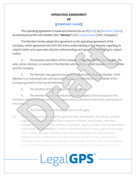1 min read
What is a Foreign LLC and Do You Need to Register? A Complete Guide
If you formed your LLC and you “do business” in other states, you need to file for foreign registration in those states that tells the state that...
8 min read
LegalGPS : Oct. 25, 2024
Welcome to another of our informative blog posts aimed at demystifying complex legal topics. Today, we're addressing something that many solo entrepreneurs often overlook—the Membership Interest Purchase Agreement, also known as an MIPA. For a single business owner, understanding the role and importance of this contract is vital.


Membership Interest Purchase Agreement (Simple Single Owner)
Simplify membership interest purchases for single owners with our legal template ensuring clear terms and conditions and smooth ownership transfer.
Trusted by 1,000+ businesses to safeguard their LLCs.
Basically, a Membership Interest Purchase Agreement is a legal contract that facilitates the sale and transfer of ownership interests in a company from one party to another. However, it's not as simple as it sounds, and there are several key components to it.
Imagine that you're the sole owner of a Limited Liability Company (LLC). At some point, you may want to bring on board a partner, or perhaps you've decided to sell the company altogether. Here's where the Membership Interest Purchase Agreement comes into play. It lays down the terms and conditions for the transfer of ownership, ensuring that all parties involved are on the same page.
When writing an MIPA, the idea is to cover all bases and leave no room for ambiguity. Here are some key elements to include:
Details of Parties Involved: The agreement should clearly state the names and addresses of the seller (the current owner) and the purchaser.
Definition of Membership Interest: It should specify what "membership interest" pertains to—this generally includes elements like assets, profits, capital, voting rights, etc., linked to the ownership.
Purchase Price: The amount that the purchaser will pay to the seller for acquiring the membership interest.
Payment Method: The terms of payment should be outlined here, whether it's to be made in a full one-time payment, or in installments.
Closing and Possession Date: The date when the deal will be closed and when the purchaser will officially take over the ownership interest.
Representations and Warranties: Both parties make certain statements in the agreement, to assure the other of the veracity of the deal. For example, the seller might state that they indeed own the membership interest being sold.
Miscellaneous Provisions: These could include any optional clauses or additional details to protect both parties' interests.
Alright, now that you are up to speed with what a Membership Interest Purchase Agreement is and what it usually contains, let's turn our attention to the execution. This process may sound daunting, but we'll guide you with actionable and easy-to-follow steps.
Much like how a handshake often initiates a meeting, your MIPA begins with a simple introduction. Here, you list the full names and addresses of 'Seller' (yourself, the current owner) and 'Purchaser' under their respective headings. Furthermore, you'll want to include the effective date—the date from which the terms of the contract start operating. Finally, specify the company whose membership interests are under transaction. Don't forget to include the complete and registered name of your company.
Failing at the basics can be a common mistake, which can lead to problems down the line. For example, if you don't include your company's registered name and full address (both physical and postal), then it will be difficult for any third party to identify and locate you. The same goes for the buyer—if they're left with only an incomplete or incorrect address, then how will they deliver their first monthly payment?
|
Example This is an agreement between Mr. John Doe and Mr. Smith, two individuals who are part of a company whose legal name is XYZ Investments Incorporated, for the sale of membership interests in XYZ Investments Incorporated. The terms and conditions stated below will be observed by both parties and shall apply from this date onwards. |
Now, this is the core of your agreement: describing what exactly is being sold. Generally, membership interest would cover a proportion of company assets, any claim to profits, plus any attached voting rights. Ensure you detail the ownership percentage that will be transferred and spell out any specific rights or privileges that come with the membership interest.
For instance, if the membership interest includes a right to vote on major decisions, specify that here. You can also add any restrictions on ownership such as transferability or voting rights.
|
Example XYZ Investments Incorporated’s membership interests will be sold in increments of 25% (equivalent to one unit). The price for each unit shall be $100,000 USD. Each member shall have one vote per unit purchased. Units may not be divided, sold or traded unless all parties agree in writing before the transfer takes place. |
Now to the nitty-gritty—the purchase price and the terms of payment. Clearly mention the proposed amount the Purchaser agrees to pay for the membership interests. Also, you need to clarify whether the payment will be completed in one lump sum or connected to a payment schedule. If it's the latter, jot down the number and amount of each installment, and when they're due.
Be very specific about the date by which payments must be made. If there's any doubt, include a clause stating that failure to pay by the due date will result in a default interest rate of 5% per month until payment is made.
|
Example "The Purchaser agrees to pay $50,000 USD for the Membership Interests of the LLC. The payment shall be made as follows: $20,000 USD upon signing this Agreement; and $30,000 USD on or before March 1st, 20" |
Here's where Seller and Purchaser need to provide each other with certain assurances. As a Seller, you will be required to confirm details such as:
You are the legal owner of the stated membership interest and have full authority to sell it.
The interest is free from any liens or encumbrances.
You've disclosed any material information that could affect the business.
Also, the Purchaser may have to confirm they have the necessary funds to complete the purchase, and acknowledge they've had the opportunity to ask for and review necessary info about the business.
Lastly, you will need to agree on a closing date, which is typically 30-60 days after all parties have signed an agreement.
|
Example "Purchaser agrees that Seller is the legal owner of the membership interest as described above and has full authority to sell it. Purchaser acknowledges that he/she has had the opportunity to ask for and review any material information about this business." |


Legal GPS Pro
Protect your business with our complete legal subscription service, designed by top startup attorneys.
To protect the integrity of the negotiation process, both parties should consent to keep the terms of the agreement private, unless consent has been provided to share the information. Moreover, it's best to include a confidentiality clause that states that any information disclosed during the negotiation process is confidential and may not be shared without written permission from both parties.
This helps protect the business from leaks and helps both parties feel more comfortable sharing information. This clause can be included in the agreement by adding this text: "Purchaser and Seller agree that any information disclosed during negotiations will be kept confidential unless consent has been provided to share said information."
|
Example "Purchaser and Seller agree that, other than in connection with a legal proceeding to enforce this agreement or as otherwise required by law, neither party will disclose any information about the transaction, except as specifically permitted by this agreement. This includes all financial details regarding the purchase of the membership interest in [business name]." |
The agreement must state the laws of which state govern the contract’s interpretation, the rights of the parties, and any disputes. This is important because the laws of the state where you live and do business will apply. If you have a contract that’s governed by the law of another state or country, then it may be unenforceable in court.
A Governing Law will help you avoid this issue. The final section of the contract should also specify that any disputes between you and the seller will be resolved by binding arbitration, rather than a lawsuit in court.
|
Example “This agreement is governed by the laws of the State of [STATE] without regard to its conflict-of-law provisions. The parties agree that any action related to this contract must be filed in a court within [STATE], and each party irrevocably consents to jurisdiction and venue in those courts for all purposes.” |
Finally, don't forget the all-important signature section. Include a space for both the Seller and Purchaser, and the date they signed the agreement.
This section seals the deal and makes it official. It also prevents either party from claiming that the contract was invalid because they didn't sign it or that they signed it under duress (meaning someone forced them to agree).
|
Example “Seller and Purchaser have executed this agreement on [DATE], as indicated below.” |
Remember, being meticulous and paying attention to each and every detail here can save you from future loopholes and misunderstandings.


Legal GPS Pro
Protect your business with our complete legal subscription service, designed by top startup attorneys.
As a single owner, you might think, "Why do I need this agreement?" Well, let me tell you, it's always better to be prepared. Here are some reasons why you should consider having a Membership Interest Purchase Agreement:
Security: One of the major benefits of having an MIPA as a single owner is that it offers a level of security and protection in various transactions.
Clarity & Transparency: It brings clarity and transparency to the process since it lays out all the information in a structured manner.
Conflict Prevention: Potential conflicts can be prevented as all terms and conditions are stated outright.
Eliminates the need to renegotiate: It eliminates the need to renegotiate terms if there is a disagreement between the buyer and seller.
Ensures that both parties are on the same page: The agreement ensures that both parties are on the same page with regard to ownership of property, payment schedules and other important matters.
Gives both parties a clear understanding of their responsibilities: The agreement gives both parties a clear understanding of their responsibilities, including what happens if the seller fails to deliver on his part of the deal.
Provides a basis for resolving disputes: The agreement provides a basis for resolving disputes, which is especially important if there are language barriers between the buyer and seller.
Get Your Membership Interest Purchase Agreement Template
with a Legal GPS Subscription
We all can make mistakes when dealing with legal paperwork, especially if it's your first time. But don't worry, we've got your back. Watch out for these common blunders.
Vagueness: Be as detailed as possible with all the elements of the agreement. This helps to reduce any chance of misinterpretations or disputes.
Skipping Professional Review: Contract law can be tricky, and even if you think your contract is airtight, have a legal professional review it.
Overlooking Negotiable Terms: Remember, everything in a purchase agreement could be negotiable. Don't settle for less when you could negotiate for better terms.
Failing to Set Deadlines: This is a common mistake, especially for first-time home buyers. However, a contract is only binding if both parties sign it. If you and your seller aren't on the same page, it could lead to delays that could be costly in the long run.
Not Reviewing Documents: Don't just skim through documents; read everything thoroughly before signing anything.
Failing to Consider the Seller's Motives: It may be tempting to focus on how much money you can save in closing costs by negotiating those out of the purchase agreement. However, if it means that you'll have to pay more for repairs or upgrades later on down the road because the seller didn't disclose them
Taking the step from being a solo business owner to onboard other members can be quite a switch. It’s in these key moments that having a solid Membership Interest Purchase Agreement in place can help secure your position, all the while ensuring legal transparency.
Remember, knowledge is power. Now that you've understood the crux of an MIPA, you can proceed confidently. If you'd like some help with contract templates, check out our offerings. We're here to make legal matters accessible and manageable for you. Good luck!

Membership Interest Purchase Agreement (Simple Single Owner)
Simplify membership interest purchases for single owners with our legal template ensuring clear terms and conditions and smooth ownership transfer.
Trusted by 1,000+ businesses to safeguard their LLCs.
The biggest question now is, "Do I need a business attorney?” For most businesses and in most cases, you don't need a lawyer to start your business. Instead, many business owners rely on Legal GPS Pro to help with legal issues.
Legal GPS Pro is your All-In-One Legal Toolkit for Businesses. Developed by top startup attorneys, Pro gives you access to 100+ expertly crafted templates including operating agreements, NDAs, and service agreements, and an interactive platform. All designed to protect your company and set it up for lasting success.
Get Legal GPS's Membership Interest Purchase Agreement Template Now

Legal GPS Pro
Protect your business with our complete legal subscription service, designed by top startup attorneys.
|
Premium Template
Single-use Template |
Legal GPS Pro
Unlimited Access, Best Value |
|
|
| Choose Template | Learn More |
| Trusted by 1000+ businesses | |

1 min read
If you formed your LLC and you “do business” in other states, you need to file for foreign registration in those states that tells the state that...

Real estate investment offers a dynamic and profitable landscape for aspiring entrepreneurs. By acquiring, managing, and selling properties, real...

What are the minutes of an LLC meeting? They are effectively a summary of the important meetings you have in your LLC. At the initial meeting after...